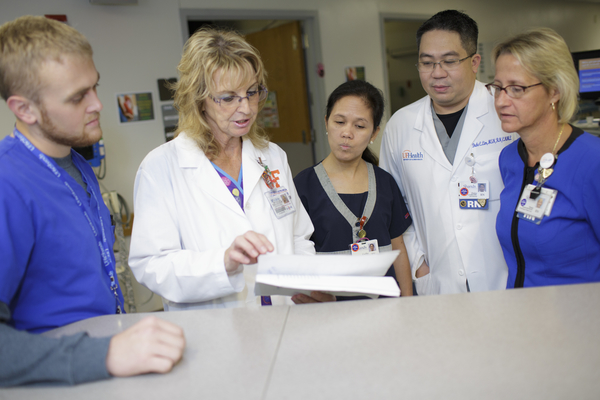The Academic Partnership Unit sounds a lot like a group of superheroes — and, at the end of the day, it may well be.
The adaptation of this model for clinical nursing education is another step in the collaboration between UF Health system’s division of nursing and the College of Nursing. The APU brings the College of Nursing and the nursing division at UF Health Shands Hospital together by placing students in nursing units — there, students observe and receive instruction from staff nurses. Generally, one nurse works with one to two students, as opposed to the previous eight to 10 students per instructor. The new model subsequently allows for more one-on-one instruction, leaving more room for questions, comments and the occasional concern.
“They’re with one nurse the majority of the time, so that nurse gets to know the students’ strengths and how they process information,” said clinical assistant professor Bonnie J. Carlin, M.S.N., R.N. “The student gets to know the behaviors and decision-making patterns of their nurse, so it becomes a trusting, working relationship.”
The nursing profession is increasingly moving beyond skills and toward clinical reasoning, or the application of critical thinking within the health care setting. Students are expected to explain how they came to a conclusion, what data led them to that conclusion and possible alternative decisions.
This means that the quality of the student-instructor relationships becomes more important than ever.
“My nurse knows me, and I know them,” said Olivia Sims, a nursing student in the unit. “There’s a comfort level there. It’s more time in the clinical setting, more learning and more time observing what my nurse can do to help the patient.”
Another change from the previous model is the duration of the students’ time with the unit. Rather than rotating after eight weeks to a different unit — where they would acquaint themselves with new staff, patients, conditions and equipment — the students remain with the same unit for four semesters.
“It’s one of the harder things for a student to adapt to,” said Duke Lim, M.S.N., R.N., associate vice president of nursing and patient services at UF Health Shands Hospital. “Learning codes and where stuff is located … that’s something you have to get accustomed to. If you’re only there for an eight-week clinical rotation, two or three weeks of that would be orienting yourself. This model is a consistent practice and a consistent voice.”
The APU also gives College of Nursing faculty the chance to make the transition from class to clinicals as smooth as possible.
“With the collaborative partnership between UF Health Shands and the College of Nursing, we might be able to bridge the gaps sometimes experienced between practice and academia,” Carlin said. “If we listen to our students and clinical instructors about discrepancies in organized forums it could be a win-win for all.”
The model is still fairly new and used by only a handful of other academic medical centers around the country. But so far, so good.
By Dorothy Hagmajer


